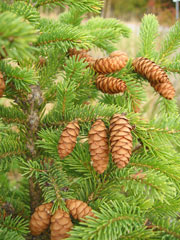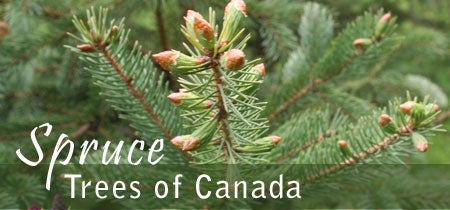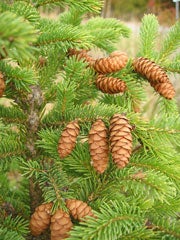
SCIENTIFIC NAME
DESCRIPTION
Spruce trees are sometimes confused with other evergreens like pine and fir trees. Pine needles are longer, even those of the Jack pine, and both pine and fir needles tend to be gentler on your fingers than spruce needles when you approach from the tips. The needles of a spruce tree are arranged all around the twig. Spruce needles are four-sided except for the flattened Sitka needles, which have a little dip at the bottom, like the keel of a boat. Another clue that you’re looking at a spruce is if there are little pegs protruding from the twig at the point where the needle attaches.
RANGE
The backbone of many northern forests, spruce trees grow all across Canada with the exception of only a few regions, like the northernmost reaches of Nunavut.
HABITAT
Spruce trees tend to prefer moist sites, although they can tolerate dry conditions. While they are shade tolerant, especially when young, they will grow more quickly and with fuller form, if grown in full sun.
DIET
BEHAVIOUR
undefinedPRIMARY ECOSYSTEM ROLES

By Sarah Coulber
The Canadian landscape wouldn’t be the same without the spruce tree, with its evergreen and bushy boughs. The backbone of many northern forests, spruce trees grow all across Canada with the exception of only a few regions, like the northernmost reaches of Nunavut.
In the lush wet forests of the west you’ll find the giant Sitka spruce towering in stands of hemlock, Douglas fir and western red cedar. Farther inland, the Engelmann spruce grows on the dry mountain slopes and along lowland streams. In the east you’ll find red spruce in moist stands of white pine, yellow birch, hemlock and sugar maple, and the black and white spruces spread across most of Canada, growing in a variety of conditions.
There are a couple of spruce varieties commonly grown in gardens and public grounds — the Norway spruce and Colorado spruce. Neither is native to Canada. The Norway is native to Europe and Asia, while the Colorado spruce, with its needles of a bluish-silvery cast, is native to the Rocky Mountains south of the Canada-U.S. border. While both varieties have attractive features, so, too, do our own native species, which have the advantage of having evolved with local wildlife for centuries.
Some native spruces have been named the provincial tree in three Canadian provinces — the white spruce in Manitoba, the red spruce in Nova Scotia and the black spruce in Newfoundland and Labrador.
Smaller spruces are suitable for urban gardens, but the larger species are best suited to properties of an acre or more. They all make an attractive green backdrop when combined with other trees and shrubs that put on a colourful display of reds, yellows and oranges in the fall, such as native maples, larch and dogwoods.
Appearance

Spruce trees are sometimes confused with other evergreens like pine and fir trees. Pine needles are longer, even those of the Jack pine, and both pine and fir needles tend to be gentler on your fingers than spruce needles when you approach from the tips. Fir needles typically look like they are growing out from the side, giving the whole branch a flattened appearance, while the needles of a spruce tree are arranged all around the twig. To see if it is a fir or spruce, check the side branches of the tree because some fir branches, like those at the top, do grow like a spruce with needles on all sides of the twig.
Spruce needles are four-sided except for the flattened Sitka needles, which have a little dip at the bottom, like the keel of a boat. Another clue that you’re looking at a spruce is if there are little pegs protruding from the twig at the point where the needle attaches. Twigs can have an orange-yellow cast to them and may or may not be hairless, depending on the species and the age of the tree.
Male and female cones are on the same tree; the female cones are a deep purple-pink and erect, while male cones are brownish yellow. Mature cones with seeds that are ready for germination (or to be eaten by birds and squirrels) are brown, hanging and ready by the autumn.
Spruce bark is typically scaly and almost pinkish-grey, with the bark of the red spruce becoming furrowed with age.
Young trees, especially when growing in the open, have a lovely conical shape with wide branches near the ground gradually tapering to a point with shorter branches at the top (crown). This shape varies, however, depending on the growing conditions, such as space, soil and light. Where you find black spruces growing closely together in the boreal forests, for example, their lower branches are bare, giving a spindly, rather than a bushy, look. Their crowns are also affected, with dense growth making them look like they are wearing hats.
Identification of spruce species can be rather tricky, with hybridization often occurring between species where their ranges overlap. Some even think that the five species are actually three or four species with the others as variations.
Uses
Spruces are the trees of choice for paper-making, general construction, crates and food boxes. John Laird Farrar notes in his Trees of Canada that aircraft during the Second World War were made from the Sitka spruce.
Their strong and flexible roots were used by Native peoples in times past for lacing up birch bark in their canoes, according to William Harlow in his book Trees of the Eastern and Central United States and Canada. He also notes that the resin, when a suitable consistency, has provided chewing gum for woodsmen!
Tom Brown, a renowned tracker who learned much Native lore first-hand, mentions spruce trees in his Field Guide to Wilderness Survival. The spruce tree’s inner bark can be dried and ground into flour, its young shoots can be eaten as a vegetable when boiled, and its crushed needles can be made into a tea, which is a rich source of vitamin C. The tea can also be used as a mouthwash for cold sores.
Of course, spruces are also one of the tree species used by Canadian families to adorn their homes at Christmas.
Spruces have an enormous value for wildlife. Birds such as white-winged crossbills, pine siskins, red-breasted nuthatches, black-capped chickadees and pine grosbeaks eat spruce seeds. Red squirrels and grouse may eat new buds, black bears and porcupines sometimes nibble the bark, while deer and rabbits browse young shoots.
With their bushy character, spruces provide birds with great protection from the cold winter winds and snow, and a place to hide from predators and to make nests. In fact, when my daughter and I set off to try to spot a bird’s nest, we soon found one neatly hidden in a 2 metre (6-foot) tall white spruce in the back garden.
Caution: We are not recommending the use of these plants for medicinal or food purposes. Many plants are poisonous or harmful if eaten or used externally. The information on food and medicinal value is only added for interest. This information has been gathered from books and its accuracy has not been tested.
Propagation

Pollination takes place in the spring when the female (seed) cones receive pollen from the male cones. The seed cones then droop downward and ripen by the end of the summer or early autumn. Collect cones and check for small seeds under the cone scales. Germinate seeds by keeping them in a moist and cold (just above freezing) place for a few weeks prior to planting.
Spruce seedlings resemble a little arm (stem) with a hand at the top, reaching upwards. After this you’ll see new growth, which more closely resembles spruce twigs and needles.
According to my tree bible, Trees in Canada by John Laird Farrar, you can copy the black spruce’s trick of reproducing by layering. This basically means you lay a branch on the ground, leaving it attached to a living tree, and cover it with some earth. Put a peg over a couple of parts, if need be, to keep the branch from springing up. After successfully rooting the branch, sever the new plant from the main tree. According to Farrar, detached stem tips can also be rooted, with younger branches rooting more easily.
Care
Spruce trees tend to prefer moist sites, although they can tolerate dry conditions. While they are shade tolerant, especially when young, they will grow more quickly and with fuller form, if grown in full sun.
According to William Cullina, author of the New England Wild Flower Society’s Native Trees, Shrubs, and Vines, budworms, bagworms and spruce gall aphids can be a problem, but mainly for those growing large stands of spruces — and only spruces. When interplanted with other species and grown in the preferred conditions of cool, moist soil, these problems don’t usually affect the trees very much, if at all.
Eastern spruce budworm and spruce sawflies and rust diseases can affect white spruce trees. Your best bet is to plant these spruces in a location where they will thrive so they can fend off these pests.
White spruce — Picea glauca
- Native to: all provinces from British Columbia to Newfoundland and Labrador, as well as Yukon, Northwest Territories and southern Nunavut. Not found in southern portions of western provinces from B.C. to western Manitoba (although found along the Rocky Mountains), coastal B.C. or the southern tip of Ontario.
- Habitat: found in a variety of growing conditions but prefers rich moist soil. Shade tolerant.
- Appearance: grows to 25 metres or more. Appearance varies according to region. Branches are typically widest on the bottom half of the tree.
Red spruce — Picea rubens
- Native to: southern Quebec, New Brunswick, Prince Edward Island, Nova Scotia. A few pockets of central Ontario.
- Habitat: found in cool moist sites, very shade tolerant.
- Appearance: grows to 25 metres high. Its mature bark, while still scaly, is more furrowed that its cousins.
Black spruce – Picea mariana
- Native to: all provinces from British Columbia to Newfoundland and Labrador, Yukon, Northwest Territories and southern Nunavut. Major exceptions are southern regions from B.C. to western Manitoba, and coastal B.C.
- Habitat: found on a variety of sites, including poorly drained sites such as bogs. Moderately shade tolerant.
- Appearance: grows to 20 to 30 metres high. Shorter forms found in wet areas, taller forms on well-drained sites. Mature trees have branches that are typically short with a dense crown, often giving it a narrow look, topped with a conical hat. Can have bushier growth in open areas. Cones are small and when opened, appear rounded. Unlike other Canadian spruces, cones may stay on the tree for many years.
Sitka spruce — Picea sitchensis
- Native to: B.C. coastline, especially Vancouver Island, Queen Charlotte Islands and northern coastal forests
- Habitat: along waterways — at the edge and several kilometres inland. Will grow in moist environments in well-drained soil
- Appearance: grows up to 55 metres although a 95-metre specimen apparently lives on Vancouver Island. It is the only Canadian spruce with flattened needles, with a little ‘keel’ below. Its shape is columnar with a pointed crown; branches are different lengths giving it a more open look, with gaps in between.
Engelmann spruce — Picea engelmannii
- Native to: B.C. interior almost to the northern boundary, western Rocky Mountain region of Alberta
- Habitat: mountain slopes around 1,500-metre elevations, along waterways at lower elevations. Will grow in shade while a young tree.
- Appearance: grows up to 35 metres tall, sometimes more. The overall shape is a long column with a pointed crown and sometimes drooping lower branches. Branches tend to grow symmetrically. Needles aromatic when bruised. Similar to the white spruce.
Special thanks to Pierre Huppé of the Central Experimental Farm, Ottawa
Images: Sarah Coulber
